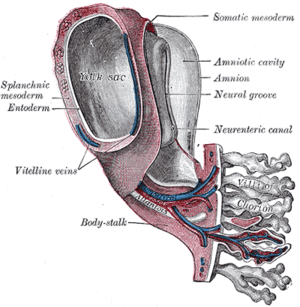Amniotic sac facts for kids
The amniotic sac is like a special bag that holds a baby (called a fetus) while it grows inside its mother during pregnancy. This bag is filled with a liquid called amniotic fluid. Both the sac and the fluid work together to keep the baby safe and help it grow.
Contents
How the Amniotic Sac and Fluid Develop
The amniotic sac begins to form and fill with fluid very early, just a few days after a woman becomes pregnant. At first, the amniotic fluid is mostly made from the mother's blood plasma (the liquid part of her blood).
What's in the Amniotic Fluid?
When it first forms, the amniotic fluid is mostly water with some electrolytes (which are like salts). But as the pregnancy continues, more things are added. By about 12 to 14 weeks of pregnancy, the fluid also contains proteins, carbohydrates, lipids (fats), and other important substances. These ingredients are vital for the baby's healthy growth.
How Much Fluid Is There?
As the baby grows bigger, the amount of amniotic fluid also increases. By the time the baby is ready to be born, there is usually about one liter of amniotic fluid inside the amniotic sac.
Why the Amniotic Fluid and Sac Are Important
The Amniotic Fluid's Job
The amniotic fluid plays many important roles in protecting the baby and helping it develop:
- It acts like a soft cushion. This protects the baby from bumps or pressure on the mother's abdomen.
- It allows the baby to float and move around freely. This movement is very important for the baby's muscles and bones to grow strong.
- It helps keep the baby at a steady, warm temperature inside the mother.
- It contains nutrients that help the baby grow and develop.
After the baby is about four months old, its kidneys start to work. At this point, the amniotic fluid has another special purpose. The baby begins to swallow the amniotic fluid. This fluid goes through the baby's digestive system and urinary system. Then, the baby urinates it back out into the amniotic fluid. This process helps the baby "practice" important skills like swallowing, digesting, and urinating before it is born.
The Amniotic Sac's Job
The amniotic sac itself has two layers, and each layer has a different job. The inner layer is the one that directly holds the baby and the amniotic fluid. The outer layer connects to the umbilical cord. This connection allows blood and oxygen from the mother to pass through the amniotic sac and reach the baby.
Checking the Amniotic Fluid
Sometimes, doctors need to check the baby's health before it is born. A small sample of amniotic fluid can be taken to see if the baby has certain genetic disorders or infections. This test is called an amniocentesis. During this test, a doctor uses a thin needle to carefully take a sample of the fluid for study.
Amniotic Sac During Birth
When a woman starts to give birth, the amniotic sac usually breaks. When this happens, the amniotic fluid leaks out. This event is often called a woman's "water breaking." Doctors refer to it as "rupture of membranes."
After the baby is born, the amniotic sac is pushed out of the woman's body. It comes out along with the placenta as part of what is called the afterbirth.
See also
 In Spanish: Saco amniótico para niños
In Spanish: Saco amniótico para niños


